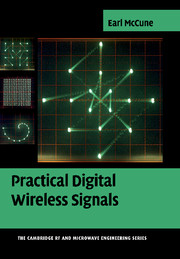Book contents
- Frontmatter
- Contents
- Preface
- Definitions and acronyms
- Terminology and notation
- 1 Keying, states, and block diagram construction
- 2 Common issues and signal characterization
- 3 Important details on results from Shannon, Nyquist, and others
- 4 Digital amplitude modulation (ASK)
- 5 Digital frequency modulation: FSK
- 6 Digital phase modulation: PSK
- 7 Combined digital modulations: QAM and OFDM
- 8 Spread spectrum
- 9 Wireless propagation and antenna fundamentals
- 10 Principles of coding
- 11 Multiple access techniques
- 12 Signal tradeoffs and system evolution
- Tutorial Appendices
- Index
- References
10 - Principles of coding
Published online by Cambridge University Press: 04 August 2010
- Frontmatter
- Contents
- Preface
- Definitions and acronyms
- Terminology and notation
- 1 Keying, states, and block diagram construction
- 2 Common issues and signal characterization
- 3 Important details on results from Shannon, Nyquist, and others
- 4 Digital amplitude modulation (ASK)
- 5 Digital frequency modulation: FSK
- 6 Digital phase modulation: PSK
- 7 Combined digital modulations: QAM and OFDM
- 8 Spread spectrum
- 9 Wireless propagation and antenna fundamentals
- 10 Principles of coding
- 11 Multiple access techniques
- 12 Signal tradeoffs and system evolution
- Tutorial Appendices
- Index
- References
Summary
Why do coding? And what is coding anyway?
From the discussion in Chapter 9 of the wireless channel, it is hopefully clear that the wireless channel is generally of low to medium reliability. This means that the probability of making an error in deciding at the receiver what was actually sent at the transmitter is actually rather high, typically 0.1 to 1%. Yet we require any communications across this channel to be of high reliability, often with probability of errors well below one part-per-million (0.0001%). It is the use of coding that allows us to achieve this goal, allowing the receiver to sort through the messy signal it usually gets and to determine what the transmitter actually sent. It should be no surprise then that nearly every DWC application uses some type of coding.
Before proceeding, we must establish what is meant here by coding. In this book, coding refers to any process where the original source data stream is changed for transmission. We also include within the heading of coding any restrictions that we may put on transitions between states that the DWC signal itself may take. Of course, these two broad types of coding are not mutually exclusive, and they can be used in combination. A conventional view of coding and how it fits within a communications link is shown in Figure 10.1.
Coding requires the addition of signal processing steps at both ends of a wireless link.
- Type
- Chapter
- Information
- Practical Digital Wireless Signals , pp. 270 - 298Publisher: Cambridge University PressPrint publication year: 2010

